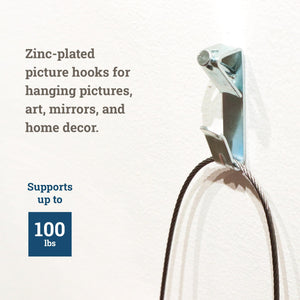Enjoy Free Shipping on Orders Over $99 within the 48 Contiguous States!
Enjoy Free Shipping on Orders Over $99 within the 48 Contiguous States!




S-HWR-2054-100X
Conventional hooks, also called nickel hooks, are traditional hook-and-wire hangers with an angled nail and a special crimp design. These picture hangers are the framing industry standard and ideal for hanging art, mirrors, home decor, and other similar wall-mounted items.
Mark the position of the hanger on the wall using a pencil, then hold the conventional hook in the marked position.
Hammer the nail gently into the nail socket until the hook is flush against the wall. Maintain the proper downward nail angle consistently; elongating the nail hole in the wall will reduce the shear strength of the hook. Do not overhammer as it will weaken the nail's grip, especially in drywall.
If you encounter a metal stud, move the hook slightly to the left or right of the stud position.
If using two hooks, space them apart evenly and repeat steps 1-2. You can also double or "gang" nickel-plated hooks by placing two or three together side by side to gain additional holding power.TIP: When hanging hook & wire hung picture frames, pictures will hang straighter and be more secure over time with two conventional hangers.
Hang the frame.
To remove nickel-plated hooks, pull back directly from the nail head at the angle of the nail using fingers, pliers, or vise grips. Prying a hook away from the wall with a screwdriver or a similar tool will often damage the wall surface.TIP: If you have to use a hammer claw to remove the nail, place a flat, solid surface, like a thin book, between the hammer's head and the wall.
To reuse a conventional hanger, ensure the hook and nail have not been bent or deformed.
